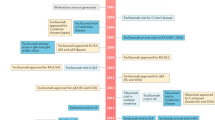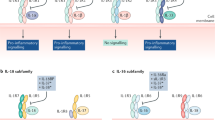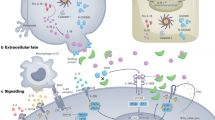Abstract
Interleukin (IL)-1R3 is the co-receptor in three signaling pathways that involve six cytokines of the IL-1 family (IL-1α, IL-1β, IL-33, IL-36α, IL-36β and IL-36γ). In many diseases, multiple cytokines contribute to disease pathogenesis. For example, in asthma, both IL-33 and IL-1 are of major importance, as are IL-36 and IL-1 in psoriasis. We developed a blocking monoclonal antibody (mAb) to human IL-1R3 (MAB-hR3) and demonstrate here that this antibody specifically inhibits signaling via IL-1, IL-33 and IL-36 in vitro. Also, in three distinct in vivo models of disease (crystal-induced peritonitis, allergic airway inflammation and psoriasis), we found that targeting IL-1R3 with a single mAb to mouse IL-1R3 (MAB-mR3) significantly attenuated heterogeneous cytokine-driven inflammation and disease severity. We conclude that in diseases driven by multiple cytokines, a single antagonistic agent such as a mAb to IL-1R3 is a therapeutic option with considerable translational benefit.
This is a preview of subscription content, access via your institution
Access options
Access Nature and 54 other Nature Portfolio journals
Get Nature+, our best-value online-access subscription
$29.99 / 30 days
cancel any time
Subscribe to this journal
Receive 12 print issues and online access
$209.00 per year
only $17.42 per issue
Buy this article
- Purchase on Springer Link
- Instant access to full article PDF
Prices may be subject to local taxes which are calculated during checkout






Similar content being viewed by others
Data availability
The data that support the findings of this study are available upon request to the corresponding author.
References
Kopf, M., Bachmann, M. F. & Marsland, B. J. Averting inflammation by targeting the cytokine environment. Nat. Rev. Drug Discovery 9, 703–718 (2010).
Lappalainen, U., Whitsett, J. A., Wert, S. E., Tichelaar, J. W. & Bry, K. Interleukin-1β causes pulmonary inflammation, emphysema, and airway remodeling in the adult murine lung. Am. J.Respir. Cell Mol. Biol. 32, 311–318 (2005).
Prefontaine, D. et al. Increased expression of IL-33 in severe asthma: evidence of expression by airway smooth muscle cells. J. Immunol. 183, 5094–5103 (2009).
Towne, J. E. & Sims, J. E. IL-36 in psoriasis. Curr. Opin. Pharmacol. 12, 486–490 (2012).
Tortola, L. et al. Psoriasiform dermatitis is driven by IL-36-mediated DC-keratinocyte crosstalk. J. Clin. Invest. 122, 3965–3976 (2012).
Garlanda, C., Dinarello, C. A. & Mantovani, A. The interleukin-1 family: back to the future. Immunity 39, 1003–1018 (2013).
Boraschi, D. & Tagliabue, A. The interleukin-1 receptor family. Semin. Immunol. 25, 394–407 (2013).
Wesche, H. et al. The interleukin-1 receptor accessory protein (IL-1RAcP) is essential for IL-1-induced activation of interleukin-1 receptor-associated kinase (IRAK) and stress-activated protein kinases (SAP kinases). J. Biol. Chem. 272, 7727–7731 (1997).
Korherr, C., Hofmeister, R., Wesche, H. & Falk, W. A critical role for interleukin-1 receptor accessory protein in interleukin-1 signaling. Eur. J. Immunol. 27, 262–267 (1997).
Hezareh, M., Hessell, A. J., Jensen, R. C., van de Winkel, J. G. & Parren, P. W. Effector function activities of a panel of mutants of a broadly neutralizing antibody against human immunodeficiency virus type 1. J. Virol. 75, 12161–12168 (2001).
Leabman, M. K. et al. Effects of altered FcgammaR binding on antibody pharmacokinetics in cynomolgus monkeys. MAbs 5, 896–903 (2013).
Hansel, T. T., Kropshofer, H., Singer, T., Mitchell, J. A. & George, A. J. The safety and side effects of monoclonal antibodies. Nat. Rev. Drug Discovery 9, 325–338 (2010).
Lee, D. W. et al. Current concepts in the diagnosis and management of cytokine release syndrome. Blood 124, 188–195 (2014).
Smith, D. E. et al. The soluble form of IL-1 receptor accessory protein enhances the ability of soluble type II IL-1 receptor to inhibit IL-1 action. Immunity 18, 87–96 (2003).
Ter Horst, R. et al. Host and environmental factors influencing individual human cytokine responses. Cell 167, 1111–1124 e1113 (2016).
Gantner, B. N., Simmons, R. M., Canavera, S. J., Akira, S. & Underhill, D. M. Collaborative induction of inflammatory responses by dectin-1 and Toll-like receptor 2. J. Exp. Med. 197, 1107–1117 (2003).
Gow, N. A. et al. Immune recognition of Candida albicans beta-glucan by dectin-1. J. Infect. Dis. 196, 1565–1571 (2007).
Martinon, F., Petrilli, V., Mayor, A., Tardivel, A. & Tschopp, J. Gout-associated uric acid crystals activate the NALP3 inflammasome. Nature 440, 237–241 (2006).
Busso, N. & So, A. Mechanisms of inflammation in gout. Arthritis Res. Ther. 12, 206 (2010).
Joosten, L. A. et al. Engagement of fatty acids with Toll-like receptor 2 drives interleukin-1beta production via the ASC/caspase 1 pathway in monosodium urate monohydrate crystal-induced gouty arthritis. Arthritis Rheum. 62, 3237–3248 (2010).
Pham, C. T. Neutrophil serine proteases: specific regulators of inflammation. Nat. Rev. Immunol. 6, 541–550 (2006).
Kakimoto, K., Matsukawa, A., Yoshinaga, M. & Nakamura, H. Suppressive effect of a neutrophil elastase inhibitor on the development of collagen-induced arthritis. Cell Immunol. 165, 26–32 (1995).
Lee, H. Y. et al. Blockade of IL-33/ST2 ameliorates airway inflammation in a murine model of allergic asthma. Exp. Lung Res. 40, 66–76 (2014).
Marrakchi, S. et al. Interleukin-36-receptor antagonist deficiency and generalized pustular psoriasis. N. Engl J. Med. 365, 620–628 (2011).
Rossi-Semerano, L. et al. First clinical description of an infant with interleukin-36-receptor antagonist deficiency successfully treated with anakinra. Pediatrics 132, e1043–e1047 (2013).
Flutter, B. & Nestle, F. O. TLRs to cytokines: mechanistic insights from the imiquimod mouse model of psoriasis. Eur. J. Immunol. 43, 3138–3146 (2013).
Libby, P. Inflammation in atherosclerosis. Arterioscler. Thromb. Vasc. Biol. 32, 2045–2051 (2012).
Grivennikov, S. I., Greten, F. R. & Karin, M. Immunity, inflammation, and cancer. Cell 140, 883–899 (2010).
Ramanan, V. K. et al. GWAS of longitudinal amyloid accumulation on 18F-florbetapir PET in Alzheimer’s disease implicates microglial activation gene IL1RAP. Brain 138, 3076–3088 (2015).
Jaras, M. et al. Isolation and killing of candidate chronic myeloid leukemia stem cells by antibody targeting of IL-1 receptor accessory protein. Proc. Natl Acad. Sci. USA 107, 16280–16285 (2010).
Ridker, P. M. et al. Antiinflammatory therapy with canakinumab for atherosclerotic disease. N. Engl J. Med. 377, 1119–1131 (2017).
Ridker, P. M. et al. Effect of interleukin-1beta inhibition with canakinumab on incident lung cancer in patients with atherosclerosis: exploratory results from a randomised, double-blind, placebo-controlled trial. Lancet 390, 1833–1842 (2017).
Bertheloot, D. & Latz, E. HMGB1, IL-1alpha, IL-33 and S100 proteins: dual-function alarmins. Cell Mol. Immunol. 14, 43–64 (2017).
Hueber, A. J. et al. IL-33 induces skin inflammation with mast cell and neutrophil activation. Eur. J. Immunol. 41, 2229–2237 (2011).
Enoksson, M. et al. Intraperitoneal influx of neutrophils in response to IL-33 is mast cell-dependent. Blood 121, 530–536 (2013).
Afonina, I. S., Muller, C., Martin, S. J. & Beyaert, R. Proteolytic processing of interleukin-1 family cytokines: Variations on a common theme. Immunity 42, 991–1004 (2015).
Guma, M. et al. Caspase 1-independent activation of interleukin-1beta in neutrophil-predominant inflammation. Arthritis Rheum. 60, 3642–3650 (2009).
Nakae, S. et al. IL-1 is required for allergen-specific Th2 cell activation and the development of airway hypersensitivity response. Int. Immunol. 15, 483–490 (2003).
Rabeony, H. et al. IMQ-induced skin inflammation in mice is dependent on IL-1R1 and MyD88 signaling but independent of the NLRP3 inflammasome. Eur. J. Immunol. 45, 2847–2857 (2015).
Possa, S. S., Leick, E. A., Prado, C. M., Martins, M. A. & Tiberio, I. F. Eosinophilic inflammation in allergic asthma. Front. Pharmacol. 4, 46 (2013).
Tanabe, T., Shimokawaji, T., Kanoh, S. & Rubin, B. K. IL-33 stimulates CXCL8/IL-8 secretion in goblet cells but not normally differentiated airway cells. Clin. Exp. Allergy 44, 540–552 (2014).
Alvarez, P. & Jensen, L. E. Imiquimod treatment causes systemic disease in mice resembling generalized pustular psoriasis in an IL-1 and IL-36 dependent manner. Mediators Inflamm. 2016, 6756138 (2016).
Sticherling, M., Sautier, W., Schroder, J. M. & Christophers, E. Interleukin-8 plays its role at local level in psoriasis vulgaris. Acta Derm. Venereol. 79, 4–8 (1999).
Hawkes, J. E., Chan, T. C. & Krueger, J. G. Psoriasis pathogenesis and the development of novel targeted immune therapies. J. Allergy Clin. Immunol. 140, 645–653 (2017).
Mashiko, S. et al. Human mast cells are major IL-22 producers in patients with psoriasis and atopic dermatitis. J. Allergy Clin. Immunol. 136, 351–359 e351 (2015).
Betz, U. A. et al. Postnatally induced inactivation of gp130 in mice results in neurological, cardiac, hematopoietic, immunological, hepatic, and pulmonary defects. J. Exp. Med. 188, 1955–1965 (1998).
Cao, X. et al. Defective lymphoid development in mice lacking expression of the common cytokine receptor gamma chain. Immunity 2, 223–238 (1995).
Cullinan, E. B. et al. IL-1 receptor accessory protein is an essential component of the IL-1 receptor. J. Immunol. 161, 5614–5620 (1998).
Dyballa, N. & Metzger, S. Fast and sensitive colloidal coomassie G-250 staining for proteins in polyacrylamide gels. J. Vis. Exp. 3, 1431 (2009).
Moore, H. B. et al. Hemolysis exacerbates hyperfibrinolysis, whereas platelolysis shuts down fibrinolysis: evolving concepts of the spectrum of fibrinolysis in response to severe injury. Shock 43, 39–46 (2015).
van de Veerdonk, F. L. et al. Protective host defense against disseminated candidiasis is impaired in mice expressing human interleukin-37. Front. Microbiol. 5, 762 (2014).
McKee, A. S., Mack, D. G., Crawford, F. & Fontenot, A. P. MyD88 dependence of beryllium-induced dendritic cell trafficking and CD4(+) T-cell priming. Mucosal Immunol. 8, 1237–1247 (2015).
Lunding, L. P. et al. Poly(inosinic-cytidylic) acid-triggered exacerbation of experimental asthma depends on IL-17A produced by NK cells. J. Immunol. 194, 5615–5625 (2015).
Fehrenbach, H. et al. Ultrastructural pathology of the alveolar type II pneumocytes of human donor lungs. Electron microscopy, stereology, and microanalysis. Virchows Arch. 432, 229–239 (1998).
Mattfeldt, T., Mall, G., Gharehbaghi, H. & Moller, P. Estimation of surface area and length with the orientator. J. Microsc. 159, 301–317 (1990).
Acknowledgements
We thank J. Domenico and M. Wade for their technical assistance, and S.H. Kim (Laboratory of Cytokine Immunology, Konkuk Univ., Republic of Korea) and M. Fujita for providing cell lines. We thank the OLAR Vivarium, the ClinImmune Flow Core Facility and the Histology Shared Resource Center funded by the University of Colorado Cancer Center NIH grant (no. P30CA046934) at the University of Colorado Anschutz Medical Campus. We also thank the University of Colorado School of Medicine Biological Mass Spectrometry Facility for analyzing IP samples. J.F.H. was supported by the Oticon Foundation, Lundbeck Foundation, Knud Højgaard Foundation and the Interleukin Foundation. M.L.V.K and B.J.S. was supported by the Interleukin Foundation. A.S.M. was funded by NIH grants no. HL126736, ES025534 and HL135872-01. C.A.D. was funded by NIH grant no. AI-15614.
Author information
Authors and Affiliations
Contributions
J.F.H. designed and performed experiments, analyzed data and wrote the manuscript. M.L.V.K. designed and performed experiments and analyzed data and assisted with manuscript preparation. A.S.M. and M.T.W. designed and performed experiments and analyzed data. T.A., L.P.L, D.M.D.G., B.J.S. and M.W. performed experiments and analyzed data. M.T. assisted in the experimental design and manuscript preparation. K.B. designed experiments and analyzed data. M.F. designed and supervised experiments and analyzed data. S.F. produced the human and mouse anti-IL-1R3 antibodies, designed experiments and analyzed data. C.A.D. designed experiments, analyzed data and edited the manuscript. All authors read and accepted the final manuscript.
Corresponding author
Ethics declarations
Competing interests
K.B. is employed by MAB Discovery GmbH, Neuried, Germany. S.F. is the CEO of MAB Discovery GmbH. All other authors declare no competing interests.
Additional information
Peer review information: Zoltan Fehervari was the primary editor on this article and managed its editorial process and peer review in collaboration with the rest of the editorial team.
Publisher’s note: Springer Nature remains neutral with regard to jurisdictional claims in published maps and institutional affiliations.
Integrated supplementary information
Supplementary Figure 1 Properties of MAB-hR3.
(a) Gating strategy for FACS analysis of MAB-hR3 and isotype binding to SK-MEL-30 and NIH-3T3 cell lines (Fig. 1b) (b) MAB-hR3 immunoprecipitate from A549 cell lysate. Gel electrophoresis of immunoprecipitate stained with collodial coomassie. The arrow at 80kDa indicate the primary location of IL-1R3 peptides as analyzed by MS. IL-1R3 peptides, presumably proteolytic breakdown products, were similar found at 60kDa (5 peptides) and 20kDa (3 peptides). (c) Viability of PBMCs using MAB-hR3 (20μg/mL or 1μg/mL) compared to media alone (percentage) (left y-axis) and viability of media alone as compared to 24hrs (right y-axis), using a WST-1 cell proliferation reagent at 24 hours, 3 days and 5 days, respectively. (d) IL-6 production in unstimulated PBMCs using MAB-hR3 (20μg/mL or 1μg/mL) alone. Assayed at 24 hours, 3 days and 5 days, respectively. Mean +SEM, data from 3 donors, all in triplicates.
Supplementary Figure 2 Properties of anti-mouse IL-1R3 antibody (MAB-mR3) and comparison to MAB-hR3.
(a+b) MAB-mR3 (a) and MAB-hR3 (b) in a murine NIH-3T3 luciferase reporter assay (NF-κB activation) stimulated with 50pg/mL of mIL-1β, relative luciferase units (RLU) depicted. (a) IC50: 281.7 ng/mL. (c+d) MAB-mR3 (c) and MAB-hR3 (d) inhibition of IL-6 production in murine NIH-3T3 cells stimulated with hIL-1β (50 pg/mL). (c) IC50: 1276 ng/mL. (e+f) MAB-mR3 in a murine NIH-3T3 luciferase reporter assay (NF-κB activation) stimulated with (e) 1ng/mL of mIL-33 (IC50: 559.5ng/mL) or (f) 170ng/mL of mIL-36γ (IC50: 65.3ng/mL), RLU depicted. (g) MAB-mR3 kinetics analyzed using SPR (1 measurement depicted). Single-cycle kinetics were done using increasing concentrations of murine IL-1R3 (0.185nM - 15nM). Data are from one representative experiment, repeated once to confirm results. (a-d) Data made in triplicates. OD; optical density. Mean + SEM depicted.
Supplementary Figure 3 Gating Strategy for analysis of bronchoalveolar cells.
Singlet cells were gated for cells to eliminate debris and analyzed for live vs dead cells. Live cells were analyzed for the presence of alveolar macrophages (Siglec F+, CD11chi) and eosinophils (Siglec F-, CD11clo). The Siglec F negative cells were analyzed for the presence of neutrophils (Ly6Ghi CD11bhi) and monocytes (Ly6Glo CD11bhi). The scatter of each population of cells was confirmed by backgating as shown.
Supplementary information
Supplementary Information
Supplementary Figs. 1–3
Rights and permissions
About this article
Cite this article
Højen, J.F., Kristensen, M.L.V., McKee, A.S. et al. IL-1R3 blockade broadly attenuates the functions of six members of the IL-1 family, revealing their contribution to models of disease. Nat Immunol 20, 1138–1149 (2019). https://doi.org/10.1038/s41590-019-0467-1
Received:
Accepted:
Published:
Issue Date:
DOI: https://doi.org/10.1038/s41590-019-0467-1
This article is cited by
-
Pro- and anti-inflammatory roles of interleukin (IL)-33, IL-36, and IL-38 in inflammatory bowel disease
Journal of Gastroenterology (2023)
-
Achaete-scute complex-like 2 regulated inflammatory mechanism through Toll-like receptor 4 activating in stomach adenocarcinoma
World Journal of Surgical Oncology (2022)
-
A preoptic neuronal population controls fever and appetite during sickness
Nature (2022)
-
IL1RAP Knockdown in LPS-Stimulated Normal Human Astrocytes Suppresses LPS-Induced Reactive Astrogliosis and Promotes Neuronal Cell Proliferation
Neurochemical Research (2022)
-
Beige adipocytes mediate the neuroprotective and anti-inflammatory effects of subcutaneous fat in obese mice
Nature Communications (2021)



